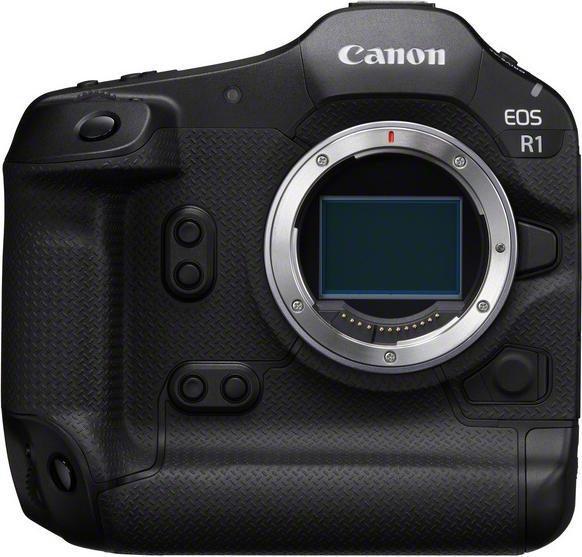

Hands-on with the Canon EOS R1: an autofocus that thinks for itself
The new sports camera from Canon is supposed to recognise who has the ball. I tested how well this works - and what else the expensive flagship has to offer.
The 1 is here: more than five years after the first RF camera, Canon is finally launching its mirrorless flagship on the market. It is designed for sports and press photography. The new camera is expected to be available from November 2024.

Like the Sony Alpha 9 III, the EOS R1 has a resolution of 24 megapixels - but, unlike the latter, no global shutter. Canon's conventional stacked sensor achieves lower continuous shooting rates. However, it could have advantages in terms of image quality. The R1 also contains a new additional chip called "DIGIC Accelerator". Among other things, this adds three new functions to the autofocus:
- With "Eye Control AF", the focus follows the photographer's gaze. The feature already exists in the EOS R3, but it is now said to work more precisely and reliably.
- The AI-supported "Action Priority" is designed to recognise the player in possession of the ball in sports scenes and keep them in focus. This initially works in football, basketball and volleyball.
- "Registered People Priority" recognises pre-registered faces and prioritises them when focussing. For example, a CEO at a press conference.
The most important key data at a glance:
How does the Canon EOS R1 perform in practice? I tried out the camera for a day at the press event in Munich. It was a pre-production model with beta firmware. The final image quality and performance may differ.
Design and operation: a lightweight beast
The R1 has a classic flagship design with a fixed vertical grip. However, it feels more modern than its predecessor, the 1DX Mark III. On the one hand, this is due to the surface structure, which is familiar from the R3. With its rounded contours, the R1 fits perfectly in the hand. Thanks to its size, it also offers support for heavy lenses.
On the other hand, the R1 is surprisingly light. At 1115 grams (including battery and memory card), it weighs 325 grams less than the old SLR (1440 grams). The Nikon Z 9 (1340 grams) is also lighter. Only the Canon EOS R3 is lower at 1015 grams.
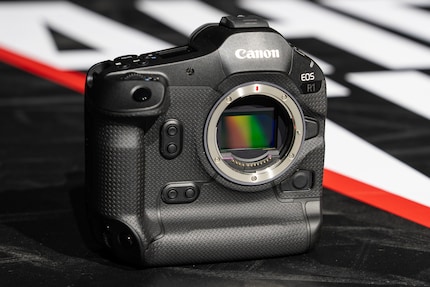
Source: Samuel Buchmann
Cameras without a fixed vertical grip are even lighter. However, press photographers who often shoot pictures in portrait format will appreciate one. Screw-on battery grips never fit so seamlessly into the body. And the bayonet is then not centred.
The workmanship of the Canon EOS R1 seems to be beyond reproach. The thing feels as if you could hammer nails into it. According to the manufacturer, the R1 is sealed to exactly the same standard as its predecessor. It should therefore survive even the most adverse conditions - whether in mud, snow or sand.
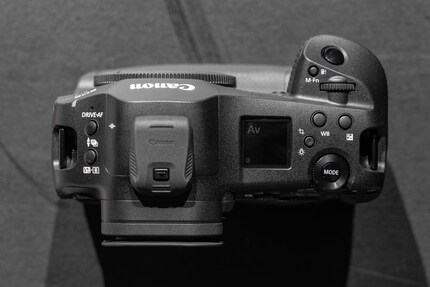
Source: Samuel Buchmann
The operation also leaves nothing to be desired. All buttons and controls are exactly where I expect them to be. They can be illuminated and have satisfactory pressure points. There are various custom buttons that I can configure individually. For example, I assign the new Action Priority to the M-Fn button next to the shutter release.
Finder and display: progress and regression
The display of the R1 is a normal "flippy screen" - it can be folded out and then rotated. It is bright and sharp, but with 2.1 million pixels it is no better than that of other cameras. Compared to the EOS R3, the screen is even worse. The LCD of the latter offers 4.2 million pixels. No idea why Canon is taking a step backwards with its flagship model.
The electronic viewfinder is another matter. Canon has finally brought this up to the current state of the art with the R1: 9.44 million pixels at 120 frames per second and 0.9x magnification. No blackout during photography. These are the same key data as Sony's top cameras. The R1's viewfinder seems to be a little brighter.
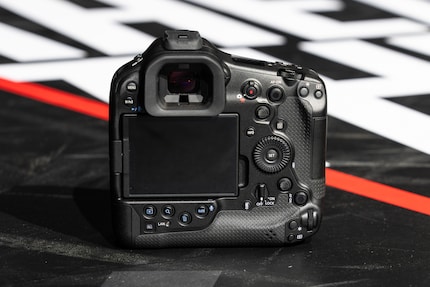
Source: Samuel Buchmann
A pleasant feature for me as a spectacle wearer: I can reduce the viewfinder image if my eye is too far away. Although this naturally reduces the resolution. As a middle way, I banish the shooting parameters to the outside. This also makes the image preview a little smaller and the composition is not disturbed by numbers.
Autofocus: fast and precise tracking
For me, Canon has made the greatest progress with autofocus. It now feels just as fast and sticky as that of the Sony Alpha 9 III, my previous benchmark. Once the Canon EOS R1 has a person in its grip, it won't let go. Even if the subject is covered in between. This is possible because the autofocus not only recognises faces and eyes, but also limbs and movements. It tries to predict the future.
If there is only one person in the picture, the hit rate in my short test is almost 100 per cent. Even in low light, the EOS R1 makes virtually no mistakes. Even if I manually focus on one of them in a scene with several people and hold the shutter button halfway down, the focus reliably captures them.
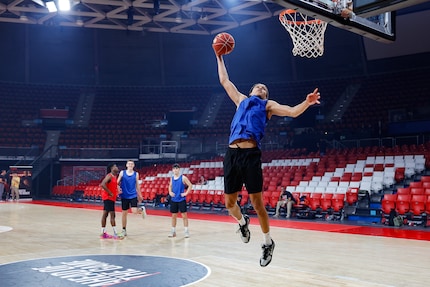
Source: Samuel Buchmann
Nowadays, other cameras can do that too. However, Canon's special functions are designed to help me automatically capture the right person. As a test scenario, I photograph a basketball training session. The aim: I want as many pictures as possible of players with the ball. As they are constantly changing, this is a challenge.
First, I try out the "Eye Control AF". It tracks my pupil with sensors on the viewfinder. The camera sets the focus wherever I look. Unfortunately, "Eye Control AF" is rather imprecise for people like me who wear glasses. Fortunately, if I have activated face recognition at the same time, the focus only has to be approximately on one person for it to be captured. That works well. At least as long as there aren't several people in a confined space.
The second thing I do is activate the "Action Priority". It should analyse the game scene and focus on the player with the ball. Sometimes it works and feels magical.
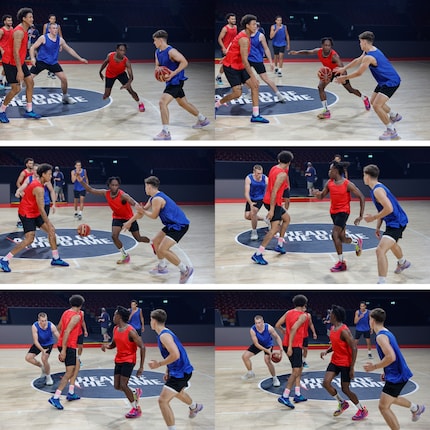
Source: Samuel Buchmann
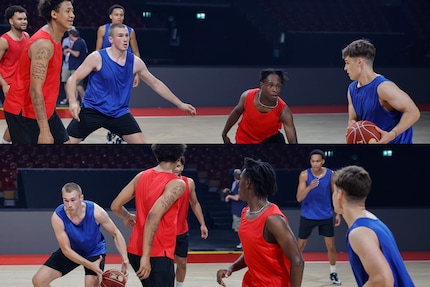
Source: Samuel Buchmann
Unfortunately, the action priority only works in about half of the cases I tested. The cut-out must not be too wide or too narrow. A half-length shot with three to four players in the picture seems ideal. Even then, the function sometimes misses the mark. So often that it seems too unreliable to me in its current state - at least for basketball. It may well work better for football with the higher contrast of a white ball on a green field.
Thirdly, I register the face of a particular player in the camera. Then I switch on the "Registered People Priority". It works brilliantly: as soon as the player appears in the scene, the camera reliably focuses on their face. This makes sense in a few cases in a sports scene. However, the function could be very helpful in other situations. For example, when an important politician is speaking at a conference and there are other people in the picture.
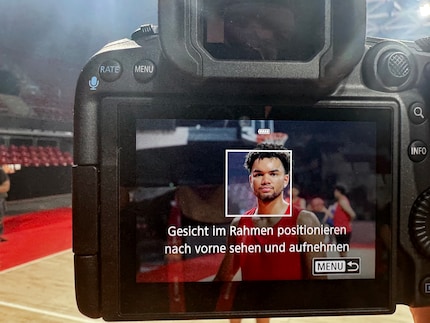
Source: Samuel Buchmann
All in all, I cannot yet assess the added value of the special functions in their current state. The ideas are good, but the action priority doesn't seem reliable enough to me. Professionals can't afford to miss an important moment because the artificial intelligence has a glitch. In everyday life, they should therefore continue to manually select the desired person using the focus zone.
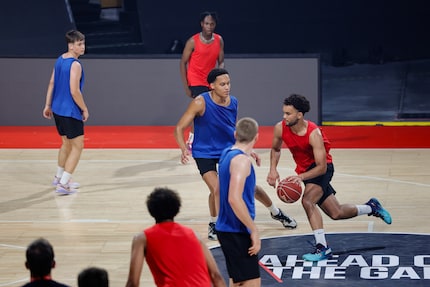
Source: Samuel Buchmann
Speed: 2nd place
Canon relies on a new stacked sensor for the EOS R1. The exact readout speed is not known. However, the rolling shutter effect with an electronic shutter is said to be lower than with a mechanical shutter. This means that a golf club in full swing becomes a little crooked. This is where the Sony Alpha 9 III with its global shutter has an advantage. But such extreme situations rarely occur.
While Sony's competitors manage up to 120 frames per second (FPS), the Canon EOS R1 "only" achieves 40 FPS. This also plays virtually no role in practice. Even 40 FPS fills the memory cards at breakneck speed. With a fast memory card, the camera maintains its maximum speed for 230 RAW images. The three continuous shooting levels can now be customised - for example to 5, 15 and 40 FPS.
The new pre-release function records images even when the shutter release button is pressed halfway - and always the last 20 images. Depending on the continuous shooting rate, these last longer or shorter. At 40 FPS it is half a second. This value cannot be set, which I think is a shame. For example, I would like to have only 5 or 10 pre-recorded images when shooting at 20 FPS. More than that just leads to unnecessary data waste.
Image quality: good first impression
The advantage of the conventional stacked sensor: in theory, it should deliver better image quality than a sensor with a global shutter. Tests on the Sony Alpha 9 III have shown that the new design reduces image noise and dynamic range by around one f-stop each.
I can't yet judge the image quality of the EOS R1 conclusively. Due to lack of time and because the RAW files cannot yet be opened. The JPGs with standard noise reduction make a good first impression. At an ISO of 12 800, the images look a little less muddy to me than with the Sony Alpha 9 III at the same sensitivity. However, I don't have a direct comparison with the same scene.

Source: Samuel Buchmann
At 24 megapixels, the resolution of the EOS R1 is low by today's standards. Canon thinks it's the sweet spot between image quality and file size for press photographers. I dare say that many would like a little more. One workaround is Canon's new upscaling directly in the camera. It quadruples the resolution - in the R1 to 96 megapixels. Allegedly, the algorithm does a better job than external software. I have not yet been able to verify this.
A similar function is available for noise reduction. Canon uses a similar "intelligent" algorithm to Lightroom. This allows less grainy images to be calculated directly in the camera. While the result in Lightroom is a new RAW image, the EOS R1 always produces a JPG. This limits further processing.
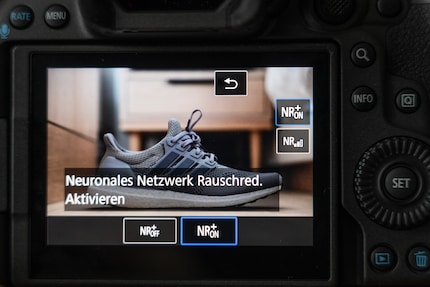
Source: Samuel Buchmann
Video: no need to hide
With its large body, the Canon EOS R1 is primarily intended as a photo camera. However, its video functions have nothing to hide from other hybrid models. The powerful chips also process 4K videos at 60 FPS using the oversampling method from 6K. The camera only switches to line skipping at 120 FPS. All without cropping. The rolling shutter is extremely well under control even with 4K oversampling at 30 FPS.
The autofocus also does an excellent job with videos. My first impression: Canon seems to have finally caught up with Sony here. Detailed tests will have to show whether this also applies to low light performance and dynamic range.
First conclusion: a worthy flagship
Canon has set the right priorities. The large but lightweight body of the EOS R1 feels great in the hand, the operation is well thought out down to the last detail and the viewfinder is one of the best.
Canon catches up with Sony when it comes to autofocus: The R1 seems to claw and hold on to faces just as well as the Sony Alpha 9 III. In addition, Canon has innovative ideas with Action Priority and the improved Eye Control AF. In their current state, however, both functions are not reliable enough for me. The priority focussing of registered faces, on the other hand, worked well during the short test.
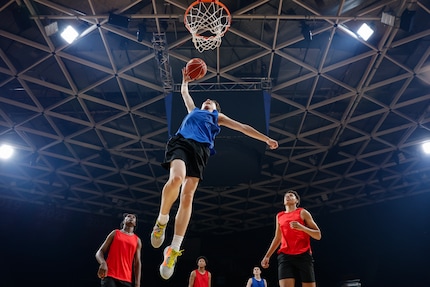
Source: Samuel Buchmann
Canon's stacked sensor is perhaps currently the best compromise for press photographers. It does not completely eliminate distortion like Sony's sensor with global shutter. But the rolling shutter is so well under control that it only becomes visible in extreme situations. The RAW continuous frame rate of 40 FPS (the Alpha 9 III achieves 120 FPS) is also perfectly adequate. In theory, the EOS R1 should deliver better image quality, but this cannot yet be assessed.
The only fly in the ointment: The resolution of 24 megapixels does not allow for extreme crops. Canon's upscaling function doesn't seem to be bad. But it is no substitute for a higher native resolution. Otherwise, the Canon EOS R1 leaves a consistently excellent first impression.
My fingerprint often changes so drastically that my MacBook doesn't recognise it anymore. The reason? If I'm not clinging to a monitor or camera, I'm probably clinging to a rockface by the tips of my fingers.
From the latest iPhone to the return of 80s fashion. The editorial team will help you make sense of it all.
Show all
